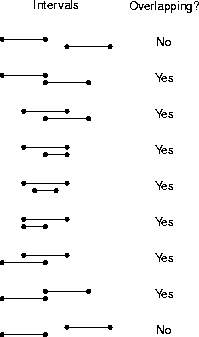
This program is supposed to determine if two intervals overlap. An extreme case of two intervals overlapping occurs at the endpoints: what happens if the two intervals share only an endpoint?
$ g++ -o la4 la4.cc $ la4 Input four integers: 1 3 3 5 The interval [1, 3] does not overlap with the interval [3, 5]. Input four integers:
overlapping(), and sure enough, the test for overlapping only checks to
see if the second interval is contained entirely within the first interval:
return ((iarray[0] <= iarray[2]) && (iarray[2] <= iarray[1])) &&
((iarray[0] <= iarray[3]) && (iarray[3] <= iarray[1]));
What characterizes the overlapping intervals? It seems easier to characterize the non-overlapping intervals; if two intervals are not non-overlapping, then tney must be overlapping.
From the picture, two intervals are non-overlapping if the smallest value in the second interval is greater than the largest value in the first interval (top interval pair) or if if the largest value in the second interval is less than the smallest value in the first interval (bottom interval pair) or
return !((iarray[1] < iarray[2]) || (iarray[3] < iarray[0]))
overlapping() seems to do the trick:
$ g++ -o la4 la4.cc $ la4 Input four integers: 1 3 3 5 The interval [1, 3] overlaps with the interval [3, 5]. Input four integers: 1 3 -1 1 The interval [1, 3] overlaps with the interval [-1, 1]. Input four integers:
Input four integers: 5 1 3 2 The interval [5, 1] does not overlap with the interval [3, 2]. Input four integers:
overlapping(),
the problem soon becomes clear: the intervals are entered backward. That is,
overlapping() implicitly assumes that iarray[0] <= iarray[1] and
iarray[2] <= iarray[2]. Had we been paying attention, we might have
caught this earlier when talking about comparing the largest and smallest
values in the intervals.
The fix for this is a bit tricky because iarray is const and so can't
be changed. While we can delete the const qualifier, it's not a good idea
to change the interface (especially when the change makes the interface less
secure); instead we'll make a copy of the input array, ordering the elements as
their being copied:
static bool overlapping(const int iarray[]) {
// Return true if the interval [iarray[0], iarray[1]] overlaps with the
// interval [iarray[2], iarray[3]]. Two intervals overlap if at least one
// integer appears in both intervals.
int ia[4];
copy_and_swap(ia, iarray, 0);
copy_and_swap(ia, iarray, 2);
return !((ia[1] < ia[2]) || (ia[3] < ia[0]));
}
copy_and_swap() is
static void copy_and_swap(int to[], const int from[], int i) {
// Store the smaller of the two values from[i] and from[i + 1] in to[i];
// store the larger of the two values from[i] and from[i + 1] in to[i + 1].
if (from[i] <= from[1]) {
to[i] = from[i];
to[i + 1] = from[i + 1];
}
else {
to[i] = from[i + 1];
to[i + 1] = from[i];
}
}
$ g++ -o la4 la4.cc $ la4 Input four integers: 1 3 3 5 The interval [1, 3] overlaps with the interval [3, 5]. Input four integers: -1 1 1 3 The interval [-1, 1] overlaps with the interval [1, 3]. Input four integers: 5 1 4 2 The interval [5, 1] overlaps with the interval [4, 2]. Input four integers:
This page last modified on 18 July 2001.